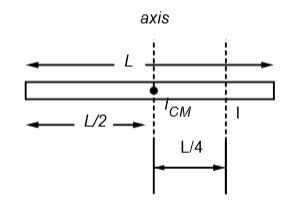
Moment of inertia of a thin rod of mass m and length l about at axis passing through a point $ \dfrac { l }{ 4 }$ from one and perpendicular to the rod is:
$A. \dfrac { m{ l }^{ 2 } }{ 12 }$
$B. \dfrac { m{ l }^{ 2 } }{ 13 }$
$C. \dfrac { 7m{ l }^{ 2 } }{ 48 }$
$D. \dfrac { m{ l }^{ 2 } }{ 9 }$
Answer
574.8k+ views
Hint: Use the theorem of parallel axes. Substitute the values in the formula and get a moment of inertia of a thin rod of mass m and length l about at the axis passing through a point $ \dfrac { l }{ 4 }$ from one and perpendicular to the rod.
Formula used:
$I ={ I }_{ CM } + m{ d }^{ 2 }$
Complete answer:

Given: $d= \dfrac { l }{ 4 }$
According to the theorem of parallel axes,
$I= { I }_{ CM } + m{ d }^{ 2 }$ …(1)
where, I: Moment of inertia of thin rod
${ I }_{ CM }$: Moment of Inertia at center of mass
But, we know ${ I }_{ CM } = \dfrac { 1 }{ 12 } m{ l }^{ 2 }$
Therefore, substituting the values in the equation. (1) we get,
$I = \dfrac { 1 }{ 12 } m{ l }^{ 2 } + m{ \left( \dfrac { l }{ 4 } \right) }^{ 2 }$
$\therefore I = \dfrac { m{ l }^{ 2 } }{ 12 } + \dfrac { m{ l }^{ 2 } }{ 16 }$
$\therefore I= \dfrac { 7m{ l }^{ 2 } }{ 48 }$
Therefore, Moment of inertia of a thin rod of mass m and length l about at axis passing through a point $ \dfrac { l }{ 4 }$ from one and perpendicular to the rod is $I = \dfrac { 7m{ l }^{ 2 } }{ 48 }$.
So, the correct answer is “Option C”.
Note:
For a uniform rod with negligible thickness, the moment of inertia about its center of mass is ${ I }_{ CM } = \dfrac { 1 }{ 12 } m{ l }^{ 2 }$. And the moment of inertia about the end of the rod is ${ I }_{ end } = \dfrac { 1 }{ 3 } m{ l }^{ 2 }$.
Formula used:
$I ={ I }_{ CM } + m{ d }^{ 2 }$
Complete answer:

Given: $d= \dfrac { l }{ 4 }$
According to the theorem of parallel axes,
$I= { I }_{ CM } + m{ d }^{ 2 }$ …(1)
where, I: Moment of inertia of thin rod
${ I }_{ CM }$: Moment of Inertia at center of mass
But, we know ${ I }_{ CM } = \dfrac { 1 }{ 12 } m{ l }^{ 2 }$
Therefore, substituting the values in the equation. (1) we get,
$I = \dfrac { 1 }{ 12 } m{ l }^{ 2 } + m{ \left( \dfrac { l }{ 4 } \right) }^{ 2 }$
$\therefore I = \dfrac { m{ l }^{ 2 } }{ 12 } + \dfrac { m{ l }^{ 2 } }{ 16 }$
$\therefore I= \dfrac { 7m{ l }^{ 2 } }{ 48 }$
Therefore, Moment of inertia of a thin rod of mass m and length l about at axis passing through a point $ \dfrac { l }{ 4 }$ from one and perpendicular to the rod is $I = \dfrac { 7m{ l }^{ 2 } }{ 48 }$.
So, the correct answer is “Option C”.
Note:
For a uniform rod with negligible thickness, the moment of inertia about its center of mass is ${ I }_{ CM } = \dfrac { 1 }{ 12 } m{ l }^{ 2 }$. And the moment of inertia about the end of the rod is ${ I }_{ end } = \dfrac { 1 }{ 3 } m{ l }^{ 2 }$.
Recently Updated Pages
Why are manures considered better than fertilizers class 11 biology CBSE

Find the coordinates of the midpoint of the line segment class 11 maths CBSE

Distinguish between static friction limiting friction class 11 physics CBSE

The Chairman of the constituent Assembly was A Jawaharlal class 11 social science CBSE

The first National Commission on Labour NCL submitted class 11 social science CBSE

Number of all subshell of n + l 7 is A 4 B 5 C 6 D class 11 chemistry CBSE

Trending doubts
What is meant by exothermic and endothermic reactions class 11 chemistry CBSE

10 examples of friction in our daily life

One Metric ton is equal to kg A 10000 B 1000 C 100 class 11 physics CBSE

1 Quintal is equal to a 110 kg b 10 kg c 100kg d 1000 class 11 physics CBSE

Difference Between Prokaryotic Cells and Eukaryotic Cells

What are Quantum numbers Explain the quantum number class 11 chemistry CBSE




